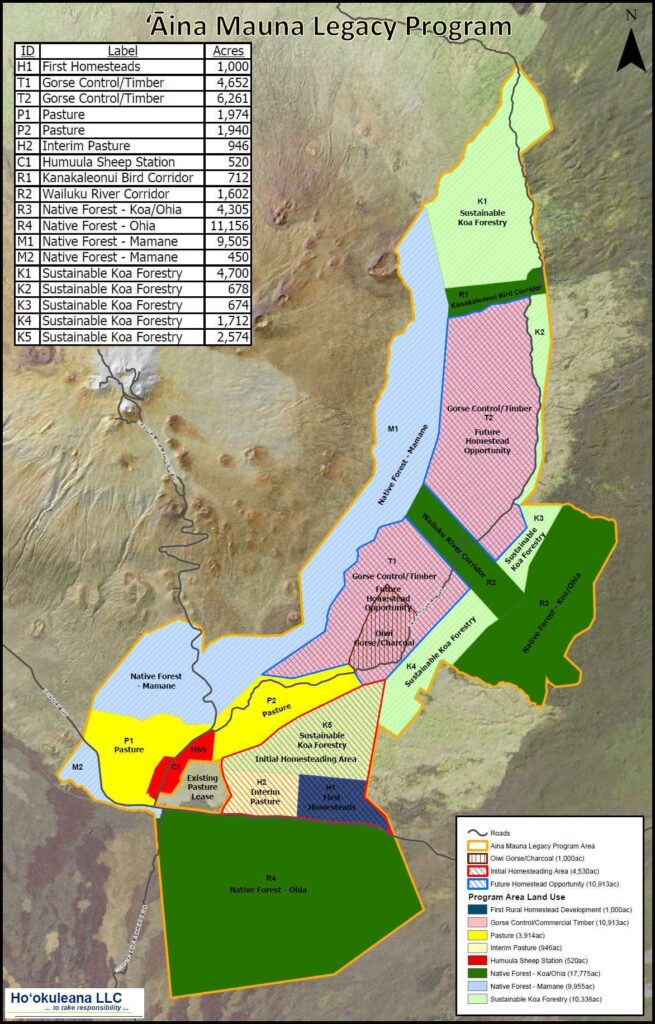Looking at land divisions on the Island of Hawaiʻi, “the common ahupuaʻa is found to be a strip say 1,000-feet average width, and running from the seashore, not by any means to the top of the mountains, but to the zone of timber land that is generally exists between 1,700 and 5,000-feet line of elevation. The ordinary ahupuaʻa extends from half a mile to a mile into this belt.”
“Then there are the large ahupuaʻa which are wider in the open country than the others, and on entering the woods expand laterally so as to cut off the smaller ones, and extend toward the mountain till they emerge into the open interior country not however to converge to a point at the tops of the respective mountains.”
“Only a rare few reach those elevations, sweeping past the upper ends of all the others, and by virtue of some privilege in bird-catching, or some analogous right, taking the whole mountain to themselves.”
“Thus Mauna Loa is shared by three great lands, Kapapala and Kahuku from Kaʻū, and Humuʻula from Hilo. Possibly Keauhou from Kona may yet be proved to have had a fourth share.”
“The whole main body of Mauna Kea belongs to one land from Hāmākua, viz., Kaʻohe, to whose owners belonged the sole privilege of capturing the ʻuaʻu, a mountain-inhabiting but sea-fishing bird.” (Kaʻohe translates to ‘bamboo;’ the name may relate to a bamboo water carrier.)
“High up on its eastern flank, however, stretched the already mentioned land of Humuʻula, whose upper limits coincide with those of the māmane, a valuable mountain acacia, and which, starting from the shore near Laupāhoehoe, extends across the upper ends of all other Hilo lands to the crater of Mokuʻāweoweo.”
“These same lands generally had the more extended sea privileges. While the smaller ahupuaʻa had to content themselves with the immediate shore fishery extending out not further than a man could touch bottom with his toes …”
“… the larger ones swept around outside of these, taking to themselves the main fisheries much in the same way as that in which the forests were appropriated.”
“Concerning the latter, it should here be remarked that it was by virtue of some valuable product of said forests that the extension of territory took place.”
“For instance, out of a dozen lands, only one possessed the right to kalai waʻa, hew out canoes from the koa forest. Another land embraced the wauke and olona grounds, the former for kapa, the latter for fish line.” (Lyons, The Islands, July 9, 1875)
“From the mass of evidence taken we find that in ancient time the main value of the land of Kaʻohe was the uwaʻo, a sea-bird, whose habitat was the dry, rocky and elevated portion of the mountain.” (Appeal from Boundary Commissioner, May 31, 1892)
Kaʻohe is an irregular ahupua‘a because it only occupies a narrow (and relatively resource-poor) band along the coast where most of the residents would have lived.
But as Kaʻohe ascends the eastern slope of Mauna Kea and emerges above the forest near 6,000-feet in elevation, it expands to occupy the entire summit region. The uplands of Kaʻohe would have contained few food resources beyond ground-nesting birds.
The primary evidence of pre-contact human utilization of Kaʻohe’s vast mountain region is the adze quarry, which would have provided Kaʻohe with a valuable resource to exchange with other ahupua‘a. (Mills)
The adze quarry area was “the largest workshops in the world for making of stone tools.” (Kenneth Emory) It covers an area of roughly 7 ½-square miles on the south slope of Mauna Kea. The main activity was concentrated in a zone that is 1-to-1½ miles wide between the 11,000 and 12,400 ft. elevation.
The landscape is dotted with numerous cinder cones, the principal one of which in the quarry area is Puʻu Koʻokoʻolau. The upper slopes of Mauna Kea have been described as a stony alpine desert. There is little vegetation and the ground surface has the appearance of a desert pavement.
Kaʻohe effectively crosses and includes all regions going from the sea to the summits of Mauna Kea and Mauna Loa. Some of the general regions include (from top to bottom:)
Kuahiwi – the mountain top, which is too high in elevation for heavy vegetation to grow. It has strong winds and extreme climates (sometimes very hot and sometimes very cold.)
Kualono – the region near the mountain top. Likewise, very few plants and animals live here. Māmane and naio (hardwoods) are the only hardy trees to grow at this height.
Waomaʻukele – the region named for the wet, soggy ground. The main trees that live in this area are the koa and ʻōhiʻa. This area was located in the rain belt of the island, especially on the koʻolau side of each island.
Waoakua – the forested region, the realm of the god and where the rain forest begins. This sacred area was kapu to most kānaka.
Waokānaka – where kānaka live and farm the land. Wood was harvested for tools, weapons and canoes; many other useful things for everyday living were gathered here.
Kula – the upland plain or open country. Pili was harvested and used mostly for thatching hale (houses).
Kahakai – the edge of the ocean. Here ʻākulikuli, with succulent green leaves, resists wind and salt water. Its leaves contain a special chemical that acts like a natural steroid.





































